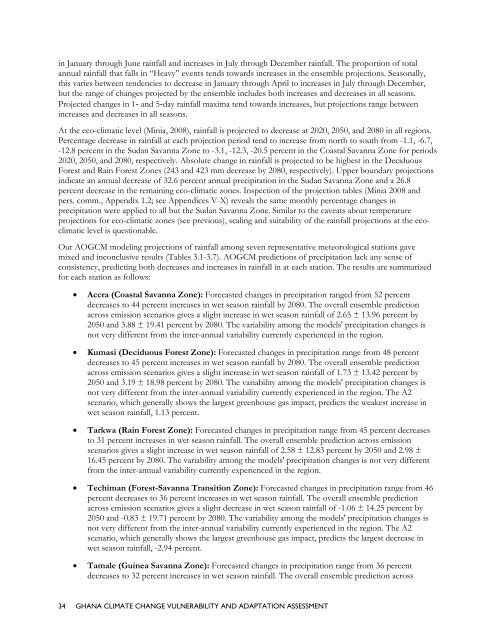ghana climate change vulnerability and adaptation assessment
ghana climate change vulnerability and adaptation assessment
ghana climate change vulnerability and adaptation assessment
- No tags were found...
Create successful ePaper yourself
Turn your PDF publications into a flip-book with our unique Google optimized e-Paper software.
in January through June rainfall <strong>and</strong> increases in July through December rainfall. The proportion of totalannual rainfall that falls in “Heavy” events tends towards increases in the ensemble projections. Seasonally,this varies between tendencies to decrease in January through April to increases in July through December,but the range of <strong>change</strong>s projected by the ensemble includes both increases <strong>and</strong> decreases in all seasons.Projected <strong>change</strong>s in 1‐ <strong>and</strong> 5‐day rainfall maxima tend towards increases, but projections range betweenincreases <strong>and</strong> decreases in all seasons.At the eco-climatic level (Minia, 2008), rainfall is projected to decrease at 2020, 2050, <strong>and</strong> 2080 in all regions.Percentage decrease in rainfall at each projection period tend to increase from north to south from -1.1, -6.7,-12.8 percent in the Sudan Savanna Zone to -3.1, -12.3, -20.5 percent in the Coastal Savanna Zone for periods2020, 2050, <strong>and</strong> 2080, respectively. Absolute <strong>change</strong> in rainfall is projected to be highest in the DeciduousForest <strong>and</strong> Rain Forest Zones (243 <strong>and</strong> 423 mm decrease by 2080, respectively). Upper boundary projectionsindicate an annual decrease of 32.6 percent annual precipitation in the Sudan Savanna Zone <strong>and</strong> a 26.8percent decrease in the remaining eco-climatic zones. Inspection of the projection tables (Minia 2008 <strong>and</strong>pers. comm., Appendix 1.2; see Appendices V-X) reveals the same monthly percentage <strong>change</strong>s inprecipitation were applied to all but the Sudan Savanna Zone. Similar to the caveats about temperatureprojections for eco-climatic zones (see previous), scaling <strong>and</strong> suitability of the rainfall projections at the ecoclimaticlevel is questionable.Our AOGCM modeling projections of rainfall among seven representative meteorological stations gavemixed <strong>and</strong> inconclusive results (Tables 3.1-3.7). AOGCM predictions of precipitation lack any sense ofconsistency, predicting both decreases <strong>and</strong> increases in rainfall in at each station. The results are summarizedfor each station as follows:Accra (Coastal Savanna Zone): Forecasted <strong>change</strong>s in precipitation ranged from 52 percentdecreases to 44 percent increases in wet season rainfall by 2080. The overall ensemble predictionacross emission scenarios gives a slight increase in wet season rainfall of 2.65 ± 13.96 percent by2050 <strong>and</strong> 3.88 ± 19.41 percent by 2080. The variability among the models' precipitation <strong>change</strong>s isnot very different from the inter-annual variability currently experienced in the region.Kumasi (Deciduous Forest Zone): Forecasted <strong>change</strong>s in precipitation range from 48 percentdecreases to 45 percent increases in wet season rainfall by 2080. The overall ensemble predictionacross emission scenarios gives a slight increase in wet season rainfall of 1.73 ± 13.42 percent by2050 <strong>and</strong> 3.19 ± 18.98 percent by 2080. The variability among the models' precipitation <strong>change</strong>s isnot very different from the inter-annual variability currently experienced in the region. The A2scenario, which generally shows the largest greenhouse gas impact, predicts the weakest increase inwet season rainfall, 1.13 percent.Tarkwa (Rain Forest Zone): Forecasted <strong>change</strong>s in precipitation range from 45 percent decreasesto 31 percent increases in wet season rainfall. The overall ensemble prediction across emissionscenarios gives a slight increase in wet season rainfall of 2.58 ± 12.83 percent by 2050 <strong>and</strong> 2.98 ±16.45 percent by 2080. The variability among the models' precipitation <strong>change</strong>s is not very differentfrom the inter-annual variability currently experienced in the region. Techiman (Forest-Savanna Transition Zone): Forecasted <strong>change</strong>s in precipitation range from 46percent decreases to 36 percent increases in wet season rainfall. The overall ensemble predictionacross emission scenarios gives a slight decrease in wet season rainfall of -1.06 ± 14.25 percent by2050 <strong>and</strong> -0.83 ± 19.71 percent by 2080. The variability among the models' precipitation <strong>change</strong>s isnot very different from the inter-annual variability currently experienced in the region. The A2scenario, which generally shows the largest greenhouse gas impact, predicts the largest decrease inwet season rainfall, -2.94 percent.Tamale (Guinea Savanna Zone): Forecasted <strong>change</strong>s in precipitation range from 36 percentdecreases to 32 percent increases in wet season rainfall. The overall ensemble prediction across34 GHANA CLIMATE CHANGE VULNERABILITY AND ADAPTATION ASSESSMENT
















